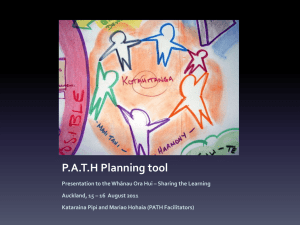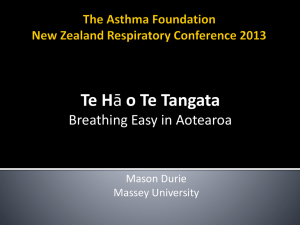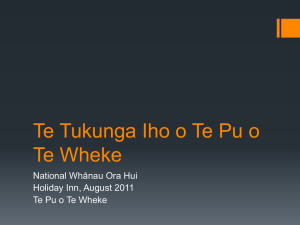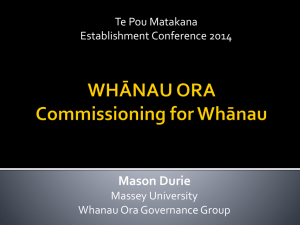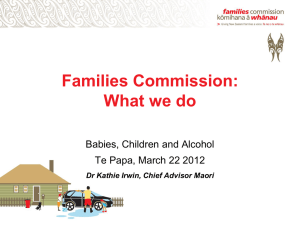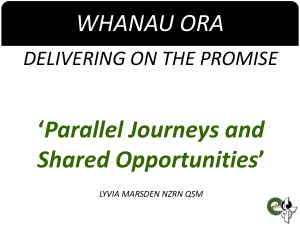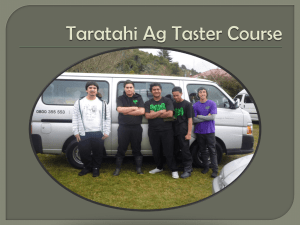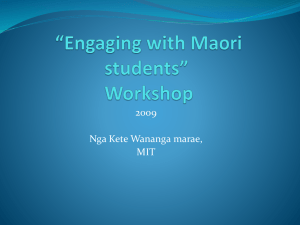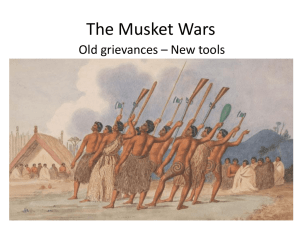Whanau Ora Summary - NUMA - National Urban Maori Authority
advertisement
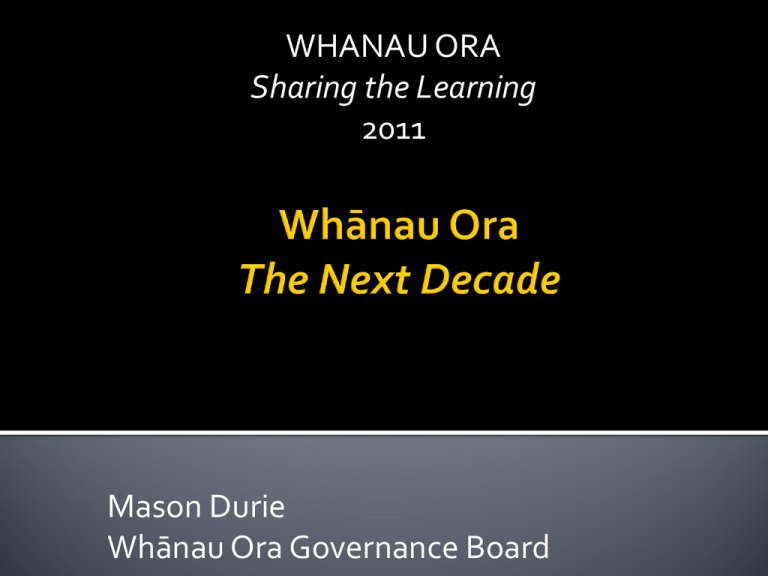
WHANAU ORA Sharing the Learning 2011 Mason Durie Whānau Ora Governance Board Sir Paul Reeves 1933 - 2011 Over the past two days, it has become clear that: Whānau potential is high and ready to be unleashed Whānau Ora provider networks are extensive, committed, innovative, and ready to learn from each other Whānau Ora is already anchored on solid foundations that will bring fresh opportunities and gains for whānau in the decade ahead. ‘It takes a village to raise a child’ ‘..believe in change and in transforming lives’ ‘Restoring trusting relationships within whanau, between whānau, providers and navigators, & with state agencies’ ‘No-0ne else can do it for us’ ‘The most important thing is to achieve good outcomes for whānau’ John Tamihere Iharaera Henare Cannons Creek Whānau Family Life Education Pasifika ‘I want to finish education for myself and for my daughter’ ‘.. A social worker who could work with people and inspire us’ • Always going to be another mountain’ • Anticipation of future roles ‘My greatest fear is to think big’ • Building bridges to carry 2way traffic ‘I want to breathe the air from the highest steps’ • Youth engagement strategies - music, art, ‘I used negative energy and turned it into inspiration’ • Relationship building over time Lianna Burns Sarah-Jane Smith ‘How can Whānau Ora play its part in ensuring that the state sector is more effective in the services it delivers to Maori ?’ TPK as a facilitator of Maori Crown relationships Leith Comer ‘The Whānau Ora landscape can influence Government as much as communities’ ‘Te Puni Kokiri is committed to playing its role’ Geoff Short, Gail Campbell, Richard Wood, Gabrielle Baker, Gerardine Clifford-Lidstone • 158 integrated contacts and 8 business cases under way • Building Whānau Ora into the core business of the state • Results based accountabilities – an approach that can accommodate individuals as well as collectives (whānau) • Whānau stories to convey the issues • Walking with provider collectives • The whānau planning space has been inspirational The background to NUMA 1.Whanau O Waipareira Trust 2.Manukau Urban Maori Authority 3.Otangarei Trust 4.Te Runanga O Kirikiriroa 5.Te Ropu Awhina ki Porirua 6.Te Runanga O Nga Mātaa Waka Willie Jackson • Whānau Ora – a legacy from earlier generations Puaoteatatu, Tu Tangata • Going further – beyond sectoral interests • The Whanau hapu Iwi continuum is as relavant to urban Maori as to others Pauline Kingi Te Ope Koiora Whānau Ora & Tainui National Urban Māori Authority ‘Walking the talk’ Pacific Nations Whānau Ora in Action The Tainui 50 year plan Catastrophe to recovery • Culture & values Social & economic transformation Forward planning Locally driven • A sense of belonging A korowai to align services with an Iwi kaupapa Marae as a disaster recovery centre • Modelling hope and change Collective action & skills Whānau Ora centres Public private partners Collaboration Whānau resilience • Champions for change Te Pū o te Wheke Pacific Care Trust Te Ao Hou Achievements • Rural access a problem but Whanua Ora kaupapa overcomes distance • Able to interact with other organisations in a climate of trust • Frank discussions even when there is still a competitive element • Able to place the difficult issues on the agenda Thinking about whānau • Whānau voices, Laughter in the house and connections with whenua • Meaningful work, Business plan preparation Whanau Ora in 5 years time •Connections with other organisations •Sharing skills, training •Happy, economically secure, engaged whānau Whānau Centred Practices Achieving Outcomes Investing in Workforce Investing in Infrastructure and Quality Governance and Leadership The Phenomena of Care Establishing the bonds Whanaungatanga Whakapapa Kaumātua Six Whānau Ora principles including relationships, care for each other, wairua PATH Model • Planning - alternative-tomorrowshope • Model for working with whānau in a planning process • Thinking beyond and beginning with the end in mind • A 12 step process Paraire Huata Kataraina Pipi Mariao Hohaia RBA Te Tukunga Iho o The Maori Way te Pu o te Wheke Value for Money What difference did you make ? Māori models Whose values One stop shops Future generations The story behind the baseline What works? Integrated contracts linked to outcomes Karen Vercoe Te Pu o te Wheke Non- $ values Investments to grow the investment Mataora Waipareira Model Whanau at the centre Drives outcomes Priviledge the organisation Nan Wehipeihana Julian King Laurie Porima Maori Organisation? The Oranganui experience • Kaupapa ake • Organisational whakapapa • Whakatauaki & policy Jennifer Tamehana Open Forum Takarangi Competency Framework 14 competencies at 4 levels Cultural knowledge and practice Clinical knowledge and practice Terry Huriwai Moe Milne Transforming Whānau A workforce that is bold, smart, creative, strategic And is Maori Shift towards what whānau will do for themselves TKA model of practice Wheturangi Walsh-Tapiata Pam Armstrong Beyond the Pretty Screen Quality in a Moodle Box Refining Quality Pacific Innovation Navigating to Outcomes IT decisions need to be based on strategic plans rather than immediate needs The Moodle box will be useful to support quality assurance, accreditation Negotiation of boundaries - Whānau Ora and Pasifika Fanau Ora and Pacific aspirations Use of Karaoke to engage with whanau – planning and integrating with ‘magic’ Carlos Martinez, Microsoft NZ Rita Paula O’Callaghan Parkin Jackie Debbie Richardson Ryan Rawiri Waititi Jacqui Harema ‘The Good the Bad & the Ugly’ Whānau Leadership & Resilience Indigenous concepts, ideologies, tools • Resilient whānau are better prepared Courage to break new ground • Principles for resilience •Whanaungatanga •Pukenga •Tikanga •Tuakiri-a-Iwi • Resilience strategies (protective and coping strategies The purpose of leadership The value of Trust Panel Discussion Poor leadership and good leadership The X factor Leadership is personal Leadership for the future Distributed leadership Doug Hauraki, MerepekaRaukawa-Tait Alfred Ngaro Jordan Waiti Whanau Centred Practice Governance & Leadership Infrastructure & Quality Whanau Ora Achieving Outcomes Workforce Phase Task Result Indicator 1 Making the case Task Force Report Feb 2010 2 Government Endorsement Minister Whanau Ora March 2010 Dedicated Whanau Ora Fund 3 Establishment • Management TPK + MoH, MSD March 2010 WIIE Fund, Whanau Centred Services Fund Governance Body April 2011 Regional Leadership Groups June 2010 25 Provider Groups identified Oct 2010 • Accountability • Identification Providers 4 5 Operationalisation • Whanau Ora Contracts • Additional contracts • Provider networking, & development ongoing Ongoing Growing the Model ongoing • 20 integrated contracts August 2011 • Further 5 + 8 providers identified • Integrated data management systems • Sharing the Learning August 2011 2011 - 2020 Establishment and Implementation phases are well underway Phases for the next decade need to be considered Phase 5 will need to contain a series of strategic goals to increase the reach and impact of Whānau Ora Phase 5a Task Socialising the model Aim • Model normalised across agencies • Whanau Impact Assessment tool applied to all Govt and Iwi policies Phase Task Aim 5a Socialising the model • Model normalised across agencies • Whanau Impact Assessment tool applied to all Govt and Iwi policies 5b Re-focussing the model Prioritisation schedules • ? Vulnerable whanau • ? Tamariki, rangatahi • ? Kaumatua Phase Task Aim 5a Socialising the model • Normalising the model across agencies • Whānau Impact Assessment tool applied to all Govt and Iwi policies 5b Re-focusing the model Prioritisation schedules • ? Vulnerable whānau • ? Tamariki, rangatahi • ? Kaumātua 5c Quantifying the model • Setting Affirmation Targets • Measuring Whānau ‘incidents’ • Measuring Whānau achievements Whānau ‘Incident ‘Targets (examples) By 2015: 30% reduction in domestic violence 50% reduction of truancy 60% reduction in rheumatic fever 25% reduction in youth offending 30% reduction in unemployment 50% reduction in welfare benefits Whānau ‘Incident ‘Targets (examples) By 2015: Whānau Achievement Targets (examples) By 2015: 30% reduction in domestic violence 60% whānau are financially literate 50% reduction of truancy 75% whānau are health literate 60% reduction in rheumatic fever 25% reduction in youth offending 30% reduction in unemployment 50% reduction in welfare benefits 60% whānau are e-literate 80% whānau are succeding in programmes of learning 60% whānau are fluent speakers of Maori 40% whānau are ‘estate’ literate Phase Task Aim 5a Socialising the model • Model normalised across agencies • Whanau Impact Assessment tool applied to all Govt and Iwi policies 5b Re-focusing the model Prioritisation schedules • ? Vulnerable whanau • ? Tamariki, rangatahi • ? Kaumatua 5c Quantifying the model • Setting Affirmation Targets • Measuring Whanau ‘incidents’ • Measuring Whanau achievements 5d Incentivising the model Rewards if targets are exceeded Penalties it targets are not met Phase Task Aim 5a Socialising the model • Model normalised across agencies • Whanau Impact Assessment tool applied to all Govt and Iwi policies 5b Re-focusing the model Prioritisation schedules • ? Vulnerable whanau • ? Tamariki, rangatahi • ? Kaumatua 5c Quantifying the model • Setting Affirmation Targets • Measuring Whanau ‘incidents’ • Measuring Whanau achievements 5d Incentivising the model ? Rewards if targets are exceeded ? Penalties it targets are not met 5e Devolving the model From state to Māori (Iwi, RLGs, Communities) Tena koutou katoa Over the past two days, it has become clear that: Whānau potential is high and ready to be unleashed Whānau Ora provider networks are extensive, committed, innovative, and ready to learn from each other Whānau Ora is already anchored on solid foundations that will bring fresh opportunities and gains for whānau in the decade ahead. The burdens carried by whānau today must be addressed. But they should not obscure the vision for tomorrow – the translation of high hopes into strong whānau who will lead communities throughout Aotearoa. The burdens carried by whānau today must be addressed. But they should not obscure the vision for tomorrow – the translation of high hopes into strong whānau who will lead communities throughout Aotearoa. If the energy, rhythm and sharing experienced at this Hui is any guide, then: Whānau Ora will come to inspire the nation and act as a beacon of hope for indigenous peoples across the globe Whānau potential is high and ready to be unleashed Whānau Ora provider networks are extensive, committed, innovative, & ready to learn from each other Whānau Ora is already anchored on solid foundations that will bring fresh opportunities and gains for whānau in the decade ahead. The Whānau Ora vision converts high hopes into strong whānau to lead communities throughout Aotearoa Whānau Ora will come to inspire the nation and act as a beacon of hope for indigenous peoples across the globe
